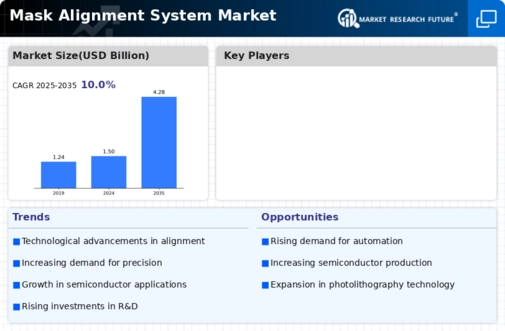Market Trends
Key Emerging Trends in the Mask Alignment System Market
The Mask Alignment System market is responding to changing technological, economic, and consumer variables. Mask alignment systems are increasingly using AI and ML. This trend improves alignment precision and efficiency, enabling real-time optimizations. Mask alignment systems can adapt to changing industrial conditions with AI and ML, improving performance and efficiency.
Industry 4.0 concepts are another Mask Alignment System market trend. Mask alignment systems are adopting smart manufacturing as industries embrace the fourth industrial revolution. Creating intelligent manufacturing environments requires connection, data analytics, and IoT integration. Industry 4.0 principles improve mask alignment efficiency, monitoring, and control, harmonizing with manufacturing's digital transition.
In the Mask Alignment System industry, environmental sustainability is becoming more important. As awareness of climate change and environmental impact rises, alignment system makers prioritize eco-friendly design and energy efficiency. Companies are using green manufacturing methods to cut energy use, waste, and meet strict environmental criteria. Eco-consciousness coincides with global efforts to promote sustainable and responsible business.
Advanced packaging technologies also affect the Mask Alignment System industry. An rising desire for downsizing and high-density packaging in semiconductor devices is forcing alignment systems to adjust. This covers wafer-level packaging and connection technology advancements. Mask alignment systems help the semiconductor industry make smaller, more powerful devices by providing the precision needed for modern packaging techniques.
In mask alignment, cobots are becoming more popular. Traditional mask alignment systems are complicated and require precise human involvement. Manufacturing is more flexible and efficient using cobots. These collaborative robots automate monotonous operations and boost workflow efficiency under human supervision.
Modular design concepts are growing in the Mask Alignment System market due to industrial demands for customization and flexibility. Manufacturers are creating modular systems that may be adjusted or upgraded to fit customer needs. This tendency makes manufacturers more versatile and scalable, allowing them to adjust quickly to product specifications and market demands.
For training and maintenance, AR and VR technologies are also growing in popularity. AR and VR enable interactive operator training and remote troubleshooting and maintenance. This trend follows the industrial shift toward digital technologies to improve operational efficiency and reduce downtime.


Leave a Comment